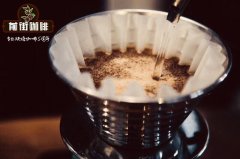Is it Arabica beans? Arabica coffee beans have high requirements for nature.

Professional coffee knowledge exchange more coffee bean information please follow the coffee workshop (Wechat official account cafe_style)
Qianjie-Arabica variety introduction
Arabica is an ancient coffee tree, just as different wheat breeds different rice. This coffee tree is more environmentally demanding and produces cleaner and richer fruit flavor.
Arabica beans grow best at 3000 feet above sea level, and the coffee is of high quality and strong aroma. But the caffeine content is only half that of Robertson beans. Arabica beans account for 80% of the global coffee trade. Its excellent flavor and aroma make it the only coffee that can be drunk directly. The world-famous Blue Mountain Coffee uses Arabica beans.
But from the fruit of a coffee tree as far away as Africa and South America to a cup of coffee in your hand, coffee beans have a long way to go. The process of transportation, the skill of the baker, the preservation time and the mode of extraction may all have a fatal impact on good coffee beans.
Ethiopia is the ancient hometown of coffee trees, and coffee trees all over the world first spread from this African land. Ethiopia is known as the coffee gene bank and is the birthplace of Arabica coffee varieties. Sidamo refers to a place in Ethiopia where coffee fruits are often bright sour and sweet.
You may not have heard the name Sidamo, but if you often go to cafes, you may have heard the barista introduce Yega Chefe. They will tell you that this is a sweet and sour bean. Yejaschuffe belongs to a smaller part of Sidamo. Unlike ordinary African coffee beans, Sidamo has clear acidity, smooth taste and delicate floral smell.
Tanning is a way to give coffee beans more sweetness. In popular terms, it's like drying raisins. In many coffee bean producing areas in Africa, water is a precious and scarce resource, and more efficient water washing treatment (coffee fruit is fermented after peeling and pectin is removed by water after fermentation) is not allowed, and sun exposure is a necessary choice. But it also brings a different fate for coffee beans.
Sun treatment says that after the coffee fruit is picked, pick out the immature fruit and miscellaneous leaves, directly expose the coffee fruit to the sun for 2 to 3 weeks, dry and remove the shell. Because the pectin is still attached to the outside, the coffee beans will have a pectin flavor (that is, more sugar will be attached to the coffee beans).
Knowledge: Ethiopia is in the position of meta-ancestor in the coffee industry, is the birthplace of Arabica beans (Arabica), and is currently the largest Arabica producer in Africa. The Kaffa forest in Ethiopia is more known as the "coffee gene bank".
In short: Qianjie is a coffee research hall, happy to share the knowledge about coffee with you, we share unreservedly just to make more friends fall in love with coffee, and there will be three low-discount coffee activities every month. The reason is that Qianjie wants to make more friends drink the best coffee at the lowest price, which has been Qianjie's tenet for 6 years!
END
Important Notice :
前街咖啡 FrontStreet Coffee has moved to new addredd:
FrontStreet Coffee Address: 315,Donghua East Road,GuangZhou
Tel:020 38364473
- Prev

What are the characteristics of Arabica beans? introduction to the flavor and taste of Arabica coffee beans
Professional coffee knowledge exchange more coffee bean information please follow the coffee workshop (Wechat official account cafe_style) front street-Arabica variety introduction "Arabica" species (Arabica) coffee beans are mainly produced in: South America (except Argentina and parts of Brazil), Central American countries, non-
- Next

Arabica coffee beans sour Arabica coffee beans taste soft fruit acid fructose
Professional coffee knowledge exchange more coffee bean information please follow the coffee workshop (Wechat official account cafe_style) front street-Arabica variety introduction Arabica coffee (Arabica) is small fruit coffee, derived from the wild coffee produced in Africa, and then introduced through Arabia to Europe and well-known name. Arabica coffee beans account for 70% of the world's coffee production.
Related
- Beginners will see the "Coffee pull flower" guide!
- What is the difference between ice blog purified milk and ordinary milk coffee?
- Why is the Philippines the largest producer of crops in Liberia?
- For coffee extraction, should the fine powder be retained?
- How does extracted espresso fill pressed powder? How much strength does it take to press the powder?
- How to make jasmine cold extract coffee? Is the jasmine + latte good?
- Will this little toy really make the coffee taste better? How does Lily Drip affect coffee extraction?
- Will the action of slapping the filter cup also affect coffee extraction?
- What's the difference between powder-to-water ratio and powder-to-liquid ratio?
- What is the Ethiopian local species? What does it have to do with Heirloom native species?

